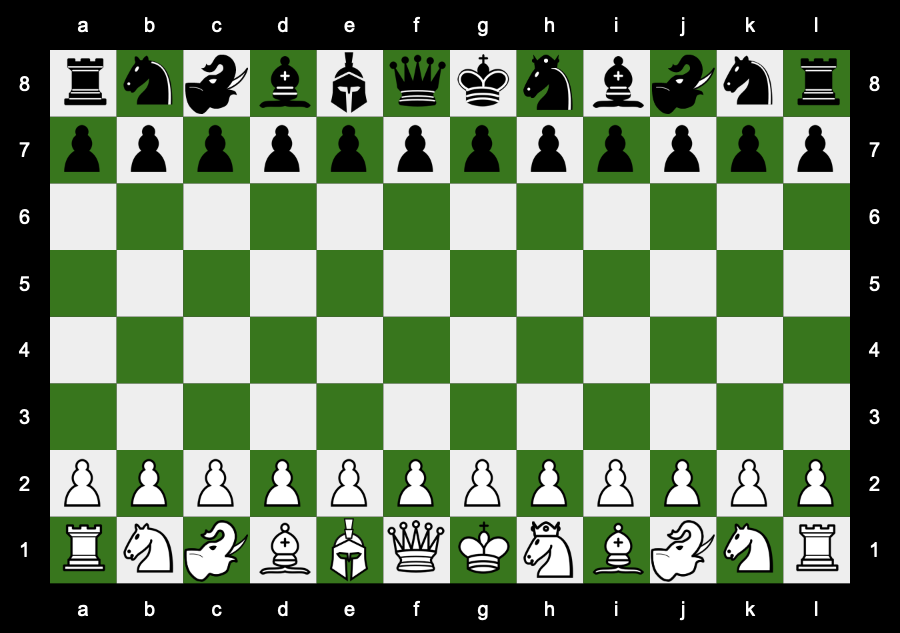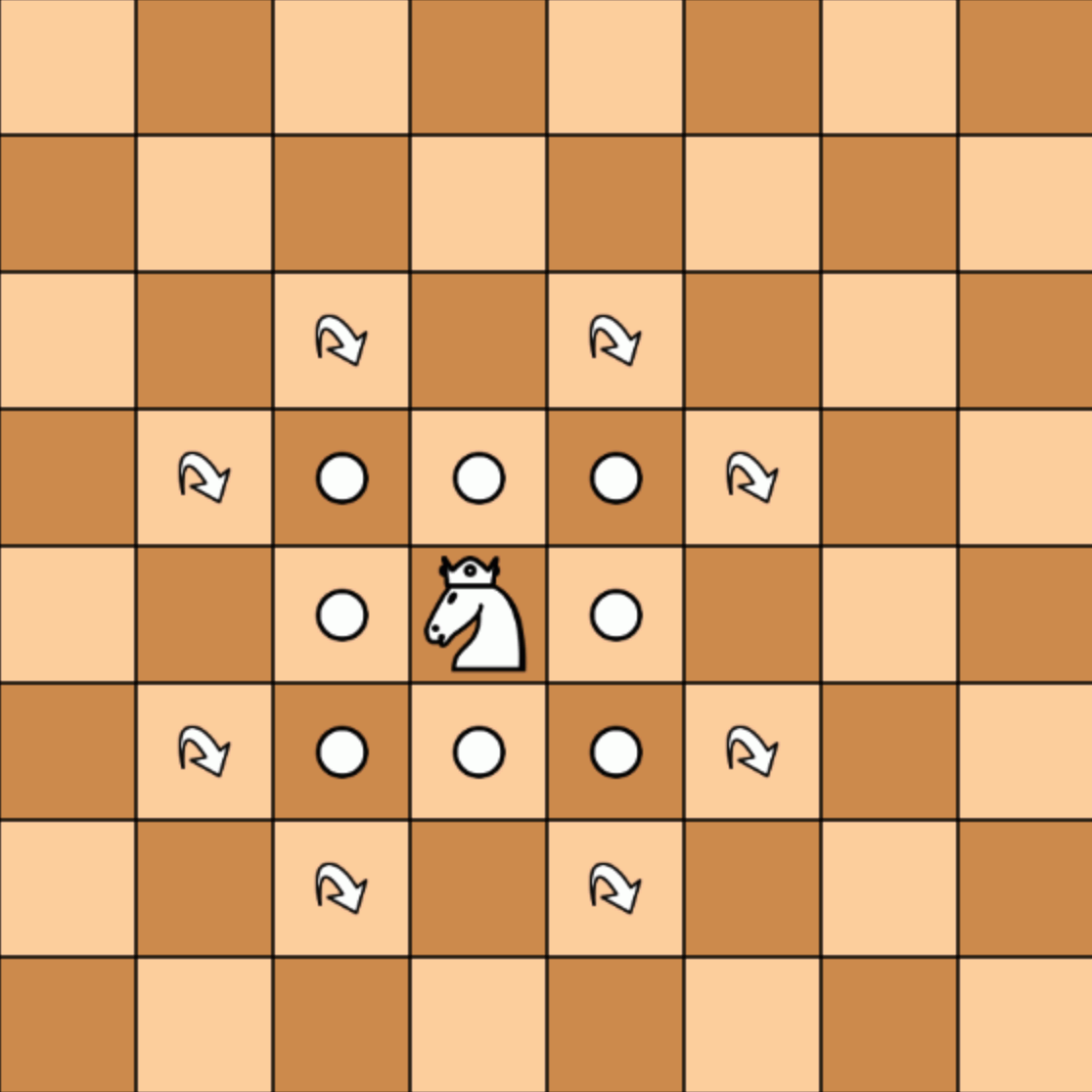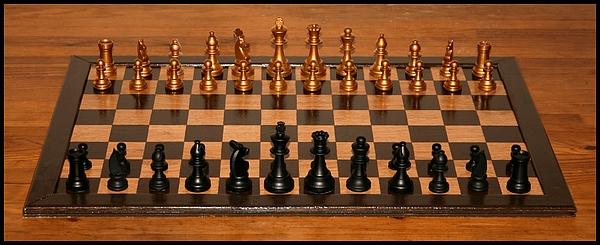Reformed Courier-Spiel
This chess variant has been invented by Clément Begnis in 2011. It is an attempt to reform the Courier-Spiel proposed by H.C. Albers in 1821 (which was itself a modernized version of the medieval Courier Chess).
With this design, Begnis also intended to improve Modern Courier Chess invented by FIDE Master Paul V. Byway in 1971.
The name and position of the pieces, the rules for castling and Pawn's promotion have been revised in comparison with Albers's and Byway's rules. Begnis has explained all his choices for the design of this game on his own web page "Reformed Courier-Spiel".
Setup
The board is a 12 x 8 checkered squares with a white one at the right end of each player. There are 24 pieces per side.
- On the 1st row: Rook/Knight/Archer/Courier/Champion/Queen/King/Paladin/Courier/Archer/Knight/Rook.
- On the 2nd row: 12 Pawns.
The white King is placed on the center of the 1st row on a black square, the black King being on a white square. The Queen lays beside the King.
This is the starting position of the pieces:

Pieces
The Rook, Knight, King, Queen and Pawn move like in modern chess. The Courier has the move of the modern Bishop
Archer: It steps diagonally one or two squares, leaping over an intervening square if it is occupied. FA in Betza's notation. Note that it always stays on the same color of square. The Archer moves as the combination of the Alfil and Ferz from Shatranj, two pieces which were also present in mediaeval Chess and have disappeared with the birth of modern moves for the Bishop and Queen. This piece is named (modern) Elephant in several modern chess variants (Shako, Metamachy, Hannibal Chess, Modern Shatranj, etc.).

Champion: It moves as a non-royal King or Dabbaba, leaping over an intervening square if it is occupied. KD in Betza's notation. It is a different piece from the Champion (WAD in Betza's) used in Omega Chess and many modern chess variants. An alternative name could be Warrior.
.png)
Paladin: It moves as a Knight or a non-royal King. KN in Betza's notation. This piece is called Centaur by problemists and is used under this name in several chess variants (Typhoon, Gigachess II, Terachess II, etc.). It is a Page in Renniassance Chess and a Judge in Sac Chess.

Rules
The goal of the game is to win by checkmating the opponent's King. The rules of stalemate and other rules of a draw are similar to those in chess. White plays first.
Castling: In Reformed Courier-Spiel castling the King moves four spaces toward the Rook (on the c- or k- column) and, in the same move, the Rook leaps over the King to stand next to it (on the d- or j-column). All conditions for castling are exactly the sames as in modern chess.
Pawn's promotion: when reaching the 8th row, the Pawn is immediately promoted to any kind of piece of the same color, just as in normal chess, including the Archer, Paladin and Champion.
Remark: The initial joy-leaps of the Rook's and Queen's Pawns and of the Queens that were supposed to be compulsory in the medieval Courier Chess are not used in Reformed Courier-Spiel.
Notes
Comparison of the central pieces in Courier Chess and several derived variants. With their name and move in Betza's notation.
| Initial square
(White's) |
Courier Chess
(historic) |
Courier Spiel
(Albers) |
Modern Courier Chess
(Byway) |
Reformed Courier-Spiel
(Begnis) |
| f1 | King
K |
King
K |
Queen
Q |
Queen
Q |
| g1 | Queen
F |
Queen
Q |
King
K |
King
K |
| e1 | Sage (Mann)
WF |
Counselor
KN |
Fers
F |
Champion
KD |
| h1 | Jester (Schleich)
W |
Fool
WF |
Fers
F |
Paladin
KN |
| d1,i1 | Courier
B |
Courier
B |
Bishop
B |
Courier
B |
| c1,j1 | Archer (Schütze)
A |
Bishop
FA |
Courier
AD |
Archer
FA |
On the opening position, Zillions-of-Games gives these pieces values, normalized to 10 for the Rook: Pawn 2.3; Knight 5; Archer 5; Courier 6.2; Champion 8.8; Paladin 11.2; Queen 15.8. According to the inventor, the following values better reflect the relative strenghts: Pawn 2.1; Knight 5.4; Archer 5.5; Courier 6.6; Champion 9.6; Rook 10; Paladin 12; Queen 16.6.
Home-made set of Reformed Courier-Spiel (Begnis)

Interactive Diagram
 This 'user submitted' page is a collaboration between the posting user and the Chess Variant Pages. Registered contributors to the Chess Variant Pages have the ability to post their own works, subject to review and editing by the Chess Variant Pages Editorial Staff.
This 'user submitted' page is a collaboration between the posting user and the Chess Variant Pages. Registered contributors to the Chess Variant Pages have the ability to post their own works, subject to review and editing by the Chess Variant Pages Editorial Staff.
Author: Jean-Louis Cazaux. Inventor: Clément Begnis.
Last revised by Jean-Louis Cazaux.
Web page created: 2023-02-05. Web page last updated: 2023-02-26
